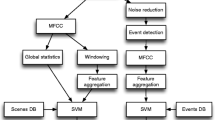Abstract
Sounds in the natural environment are non-stationary, in that their spectral dynamics is time-dependent. We develop measures to analyze the spectral dynamics of environmental sound signals and find that they fall into two categories—simple sounds with slowly varying spectral dynamics and complex sounds with rapidly varying spectral dynamics. Based on our results and those from auditory processing we suggest rate of spectral dynamics as a possible scheme to categorize sound signals in the environment.
Similar content being viewed by others
References
Allard F, Scott BL (1975) Burst cues, transition cues, and hemispheric specialization with real speech sounds. Q J Exp Psychol 27: 487–497
Belin P, Zatorre RJ, Lafaille P, Ahad P, Pike B (2000) Nature 403: 309
Binder JR, Frost J, Hammeke T, Bellgowan P, Springer J, Kaufman J, Possing E (2000) Cereb Cortex 10: 512
Cohen L (1989) Proceedings of IEEE 77: 941–981
Cohen L (1995) Time frequency analysis. Prentice-Hall, New Jersey
Cutting JE (1974) Two left-hemisphere mechanisms in speech perception. Percept Psychophys 16: 601–612
Dubnov S (2002) Generalization of spectral flatness measure for non-gaussian linear processes
Fecteau S, Armony JL, Joanette Y, Belin P (2004) NeuroImage 23: 840
Golestani N, Paus T, Zatorre RJ (2002) Anatomical correlates of learning novel speech sounds. Neuron 35: 997–1010
Hauser MD, Andersson K (1994) Left hemisphere dominance for processing vocalizations in adult, but not infant, rhesus monkeys: field experiments. Proc Natl Acad Sci USA 91: 3946–3948
Heffner HE, Heffner RS (1984) Temporal lobe lesions and perception of species-specific vocalizations by macaques. Science 226: 75–76
Hlawatsch F, Boudreaux-Bartels GF (1992) Linear and quadratic time–frequency signal representations. IEEE Signal Process Mag 9(2): 21–67
Jayant NS, Noll P (1984) Digital coding of waveforms. Prentice-Hall, New Jersy
Kurths J, Voss A, Saparin P, Witt A, Kleiner HJ, Wessel N (1995) Quantitative analysis of heart rate variability. CHAOS 5: 88
Mirman D, Holt LL, McClelland JL (2004) Categorization and discrimination of nonspeech sounds: differences between steady-state and rapidly-changing acoustic cues. Acoust Soc Am 116(2): 1198–1207
et al (1996) IEEE Trans Biomed Engg 43: 46–59
Qian S, Chen D (1996) Joint time–frequency analysis. Prentice-Hall, Upper Saddle River
Sayan GT, Sayan S (2002) Use of time–frequency representations in the analysis of stock market data. Kluwer, Dordrecht
Schubert ED (1975) The role of auditory perception in language processing. In: Duane DD, Rawson MB(eds) Reading, perception, and language. York Press, Baltimore, pp 97–130
Tchernichovski O, Mitra PP, Lints T, Nottebohm F (2001) Dynamics of the vocal imitation process: how a zebra finch learns its song. Science 291: 2564–2569
Van Steenis HG, Tulen JH (1996) Comput Biomed Res 29: 174–93
Author information
Authors and Affiliations
Corresponding author
Rights and permissions
About this article
Cite this article
Reddy, R.K., Ramachandra, V., Kumar, N. et al. Categorization of environmental sounds. Biol Cybern 100, 299–306 (2009). https://doi.org/10.1007/s00422-009-0299-4
Received:
Accepted:
Published:
Issue Date:
DOI: https://doi.org/10.1007/s00422-009-0299-4



